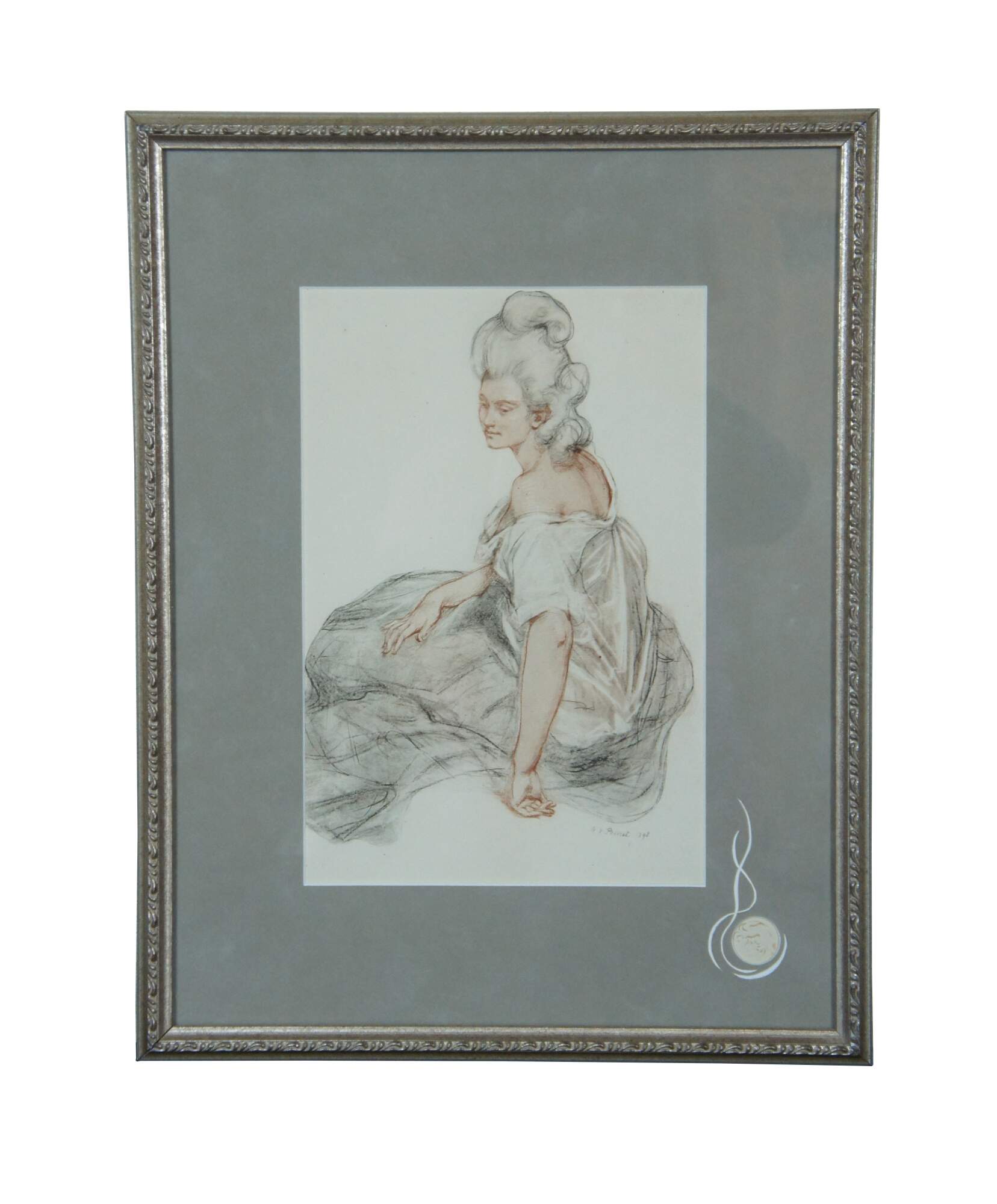
Shipping:
Free Shipping Included
Delivery:
Estimated 2-15 Business Days
Payments:
Credit Card, Check, Cash, PayPal, Apple Pay, Venmo
Returns:
30 Days 100% Money Back Guarantee, Buyer Pays Return Shipping
Description
Late 19th century antique color lithograph print titled "Manon" by Rene-Xavier Francois Prinet. Shows a female figure with tall Pompador hair do, seated, looking over her left shoulder, dressed in a loose white chemise. Giltwood frame with raised foliate detail; mottled gray mat. Lithograph on wove paper. Signed on the plate lower right margin. L’Estampe Moderne’s blind stamp on the bottom right corner. Published by Masson & Piazza, Paris.
Not unlike the Maitre de L’Affiche series, L’Estampe Moderne was a portfolio printed between 1897-98, published by Imprimerie Champenois, Paris, contained 24 monthly portfolios, with four original lithographs in each. Each was commissioned only for this series.
By PRINET René François Xavier (1861-1946)
René François Xavier Prinet (1861-1946)
Manon, 1898
"René François Xavier Prinet (31 December 1861, Vitry-le-François – 26 January 1946, Bourbonne-les-Bains) was a French painter and illustrator who drew his subjects from middle-class society. He was born to Henri Prinet, an Imperial Prosecutor in Vitry-le-François. A promotion led to him being posted in Paris, where they lived in a home not far from the École Nationale Supérieure des Beaux-Arts. His father painted as a hobby and was supportive of his desire to study art, having him seek the advice of Louis Charles Timbal [fr], a well-known church painter and friend of the family.
Around 1880, he began his studies in earnest, in the studios of Jean-Léon Gérôme; remaining with him until 1885. That year, his painting "The Infant Jesus" was accepted for display at the Salon. This was followed by studies at the Académie Julian. At this time, he also became associated with a group of young artists known as the Bande Noire (Black Stripe), which included Lucien Simon, André Dauchez, Émile-René Ménard and Charles Cottet. Later, he was named a Professor at the École Nationale, where he created and directed their first workshop for female artists. In 1891, he received a commission from the government to create decorations in the Palais de la Légion d'Honneur and he submitted a design for "The Four Seasons", which was approved. That same year, he began exhibiting at the Durand-Ruel gallery. One of his best known works, The Kreutzer Sonata (inspired by the story by Tolstoy), was shown in Stuttgart and was purchased by Luitpold, Prince Regent of Bavaria. He was named a Knight in the Legion of Honor in 1900.
He produced his first illustrations in 1909, for La Jeune Fille bien élevée [fr] (The Well-Bred Young Girl) by René Boylesve. Over the course of his career, he would illustrate works by Balzac, Pierre Loti, Anatole France and Henri Bataille; among many others. In 1913, he was appointed Secretary for the Société Nationale des Beaux-Arts and travelled to the United States; serving on the jury for an exhibition at Carnegie Mellon University, where he also presented several works. He would exhibit there again in 1920. Six years later the "Société Belfortaine des Beaux-Arts" (an adjunct of the Musées de Belfort [fr]) was established and became one of his favorite exhibition venues. His work was also part of the painting event in the art competition at the 1932 Summer Olympics. In 1943, he was elected to the Académie des Beaux-Arts to fill the chair made vacant by the death of Jules-Alexis Muenier in 1942. In addition to painting, he wrote two texts, Initiation � la peinture, in 1935, and Initiation au dessin." (Source: Wikipedia)
"L'Estampe Moderne appeared in 1897-1899 as a series of 24 monthly fascicles, each of 4 original lithographs, priced at 3 francs 50 centimes and printed by Imprimerie Champenois of Paris. Many accomplished European Art Nouveau painters contributed works to this publication. The richly lithographed prints had as a blindstamp (or embossed device), the imprint of a young woman's profile in the lower right corner.
In the 1890s various fascicles of original prints were issued by French publishers. L’Estampe originale was a quarterly edited by André Marty between 1893 and 1895 - the original L’estampe moderne was published in five folios between November 1895 and March 1896 edited by Loÿs Delteil - the second L’Estampe Moderne was published monthly between May 1897 and April 1899. The publication was edited by Charles Masson and H. Piazza. Each issue came in a paper cover bearing an original lithograph by Alphonse Mucha. The publisher offered two extra lithographs a year, the "planches de prime", as an incentive to prospective subscribers. The aim was to promote the art of printmaking by commissioning images from noted Art Nouveau artists, such as Alphonse Mucha, Louis Rhead, Marcel-Lenoir, Henri Boutet, Henri Fantin-Latour, Edward Burne-Jones and Théophile Steinlen." (Source: Wikipedia)
Condition
Good Overall - Slight discoloration/couple small spots to paper
Dimensions
15.5" x 1" x 20" / Sans Frame - 8.5" x 12.5" (Width x Depth x Height)